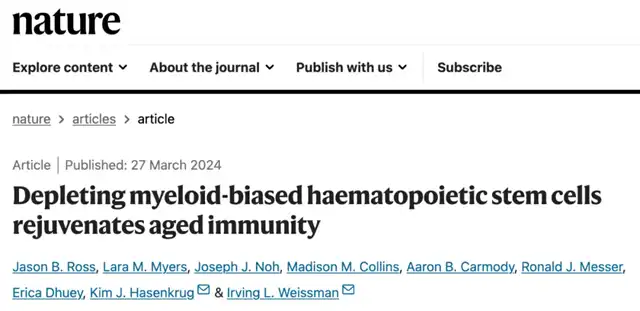A single shot that rejuvenates the immune system
- Normal Liver Cells Found to Promote Cancer Metastasis to the Liver
- Nearly 80% Complete Remission: Breakthrough in ADC Anti-Tumor Treatment
- Vaccination Against Common Diseases May Prevent Dementia!
- New Alzheimer’s Disease (AD) Diagnosis and Staging Criteria
- Breakthrough in Alzheimer’s Disease: New Nasal Spray Halts Cognitive Decline by Targeting Toxic Protein
- Can the Tap Water at the Paris Olympics be Drunk Directly?
A single shot that rejuvenates the immune system: A new anti-aging therapy restores youthful immune characteristics
- Should China be held legally responsible for the US’s $18 trillion COVID losses?
- CT Radiation Exposure Linked to Blood Cancer in Children and Adolescents
- FDA has mandated a top-level black box warning for all marketed CAR-T therapies
- Can people with high blood pressure eat peanuts?
- What is the difference between dopamine and dobutamine?
- How long can the patient live after heart stent surgery?
A single shot that rejuvenates the immune system: A new anti-aging therapy restores youthful immune characteristics
Single hematopoietic stem cells (HSCs) can generate all blood cells and self-renew to maintain a stem cell pool throughout life. HSCs are functionally heterogeneous and may contribute differently to the lymphoid and myeloid cell lineages. At least two subtypes of HSCs exist—bal-HSCs (lymphoid-myeloid balanced hematopoietic stem cells) and my-HSCs (myeloid-biased hematopoietic stem cells)—with the former capable of balancing the production of lymphoid and myeloid cells, while the latter tends to predominantly produce myeloid cells. The proportion of my-HSCs increases with age compared to bal-HSCs.
This age-related shift from bal-HSCs to my-HSCs reduces lymphoid cell production and increases myeloid cell production, leading to many pathological phenomena in the elderly, including declining adaptive immunity, inflammation, and various myeloid-related diseases. This suggests that if a treatment could be developed to return the immune system to a state with more hematopoietic stem cells (HSCs) and fewer my-HSCs, which is a younger state, thus more balanced in the production of lymphoid and myeloid cells, it might address age-related pathological phenomena.
On March 28, 2024, a study titled “Depleting myeloid-biased haematopoietic stem cells rejuvenates aged immunity” was published in the journal Nature by a team led by Irving Weissman from Stanford University and Kim Hasenkrug from the National Institutes of Health.
The research team developed an antibody therapy that targets and eliminates my-HSCs in the bodies of elderly mice, increasing the proportion and quantity of bal-HSCs, returning the elderly immune system to a youthful state, restoring youthful immune characteristics, reducing age-related decline in immune function, and enhancing protective immunity in elderly mice against viral infections.

Aging of the immune system is characterized by decreased lymphopoiesis and adaptive immunity, increased inflammation, and myeloid dysplasia. Changes in the subpopulations of self-renewing hematopoietic stem cells (HSCs) are believed to underlie these phenomena. In youth, HSCs that produce a balanced output of lymphoid and myeloid cells (bal-HSCs) predominate, promoting lymphopoiesis required for initiating adaptive immune responses while limiting the production of potentially pro-inflammatory myeloid cells. In contrast, in old age, the proportion of HSCs biased towards myeloid cell production (my-HSCs) increases, leading to decreased lymphopoiesis and increased myelopoiesis.
Two subpopulations of HSCs in mice, bal-HSCs and my-HSCs, can be distinguished based on the level of CD150 expression, with bal-HSCs expressing low levels of CD150, while my-HSCs express high levels of CD150. In addition to CD150, more than a dozen cell surface proteins, including CD41, CD61, CD62p, and NEO1, are highly expressed on the surface of my-HSCs. To identify the optimal targets on my-HSCs, the research team used antibodies and flow cytometry to assess their levels on my-HSCs and bal-HSCs.
The results showed that, compared to bal-HSCs, the most enriched cell surface proteins on my-HSCs were CD41, CD62p, and NEO1. The research team identified them, along with CD150, as candidate antigens for antibody-mediated targeting and depletion of my-HSCs and developed antibodies targeting these antigens individually.
The results showed that targeting CD150 alone with antibodies was sufficient to deplete my-HSCs in large numbers in vivo. To further enhance the efficiency of antibody-mediated clearance of my-HSCs, the research team added anti-CD47 and/or anti-KIT antibodies to the anti-CD150 antibody, resulting in a more pronounced depletion of my-HSCs approximately one week later, and an increase in the proportion and absolute number of bal-HSCs in the bone marrow. These results suggest that the combined use of anti-CD150, anti-CD47, and anti-KIT antibodies is the most effective my-HSC depletion strategy.
The study further demonstrates that targeting and clearing my-HSCs in vivo can rejuvenate the immune system, leading to more common lymphoid progenitor cells and other immune cells, while reducing age-related inflammatory markers associated with declining immune function. Additionally, elderly mice treated with this therapy showed improved immune responses to viral infections.
The conservation of the changes in HSCs and the expansion of my-HSCs during aging between mice and humans suggest that this preclinical study could support the development of clinical treatment regimens to help restore a youthful state to the human immune system, with broad implications for many age-related issues. However, further preclinical and clinical studies are needed to determine the feasibility of this immune therapy in humans.
It should be noted that increasing lymphoid cell production in old age can restore youthful immune characteristics and enhance resistance to infections, but it may also increase the risk of tumor growth (such as leukemia). Therefore, enhanced immune surveillance is needed to reveal the long-term effects of restoring youthful immune characteristics through immune therapy.
A single shot that rejuvenates the immune system: A new anti-aging therapy restores youthful immune characteristics
(source:internet, reference only)
Disclaimer of medicaltrend.org
Important Note: The information provided is for informational purposes only and should not be considered as medical advice.



